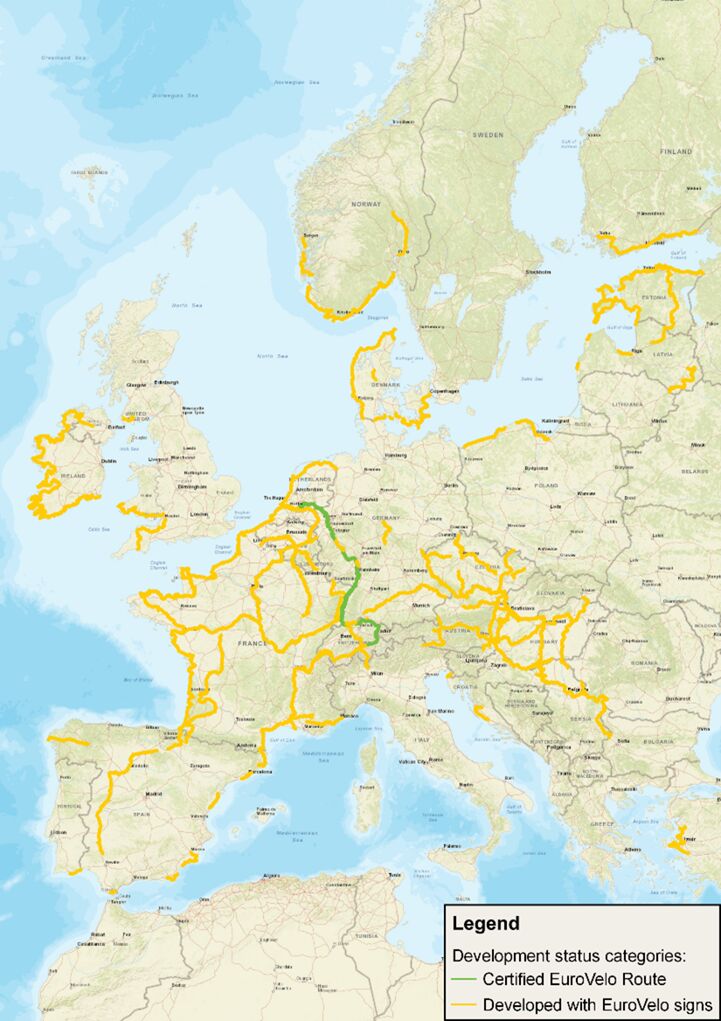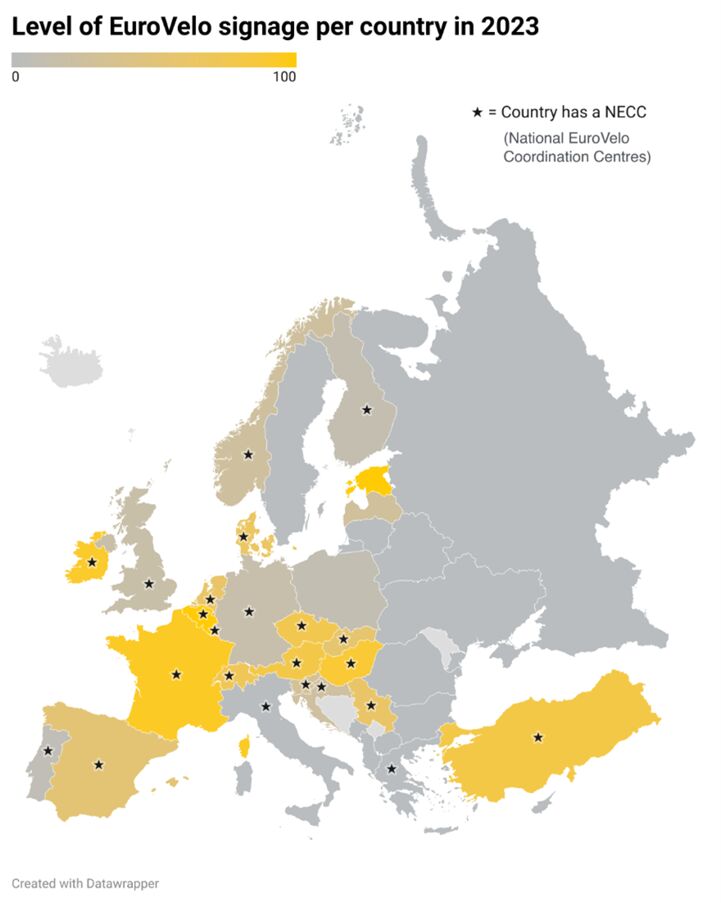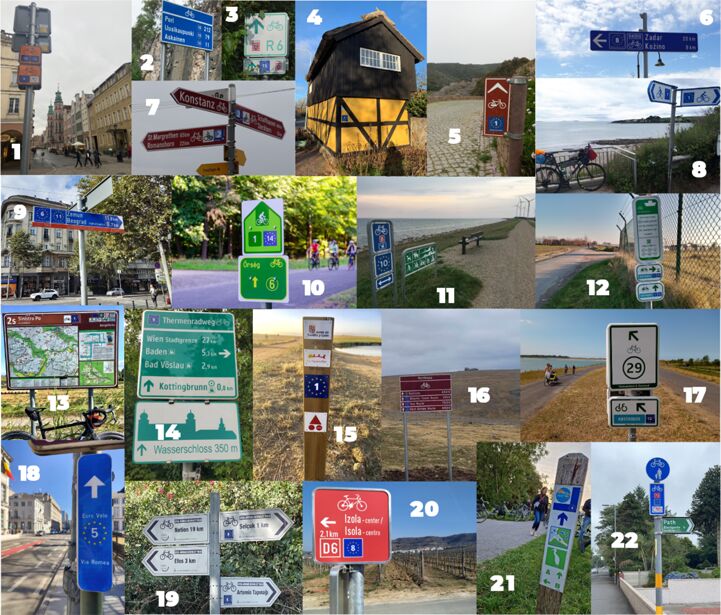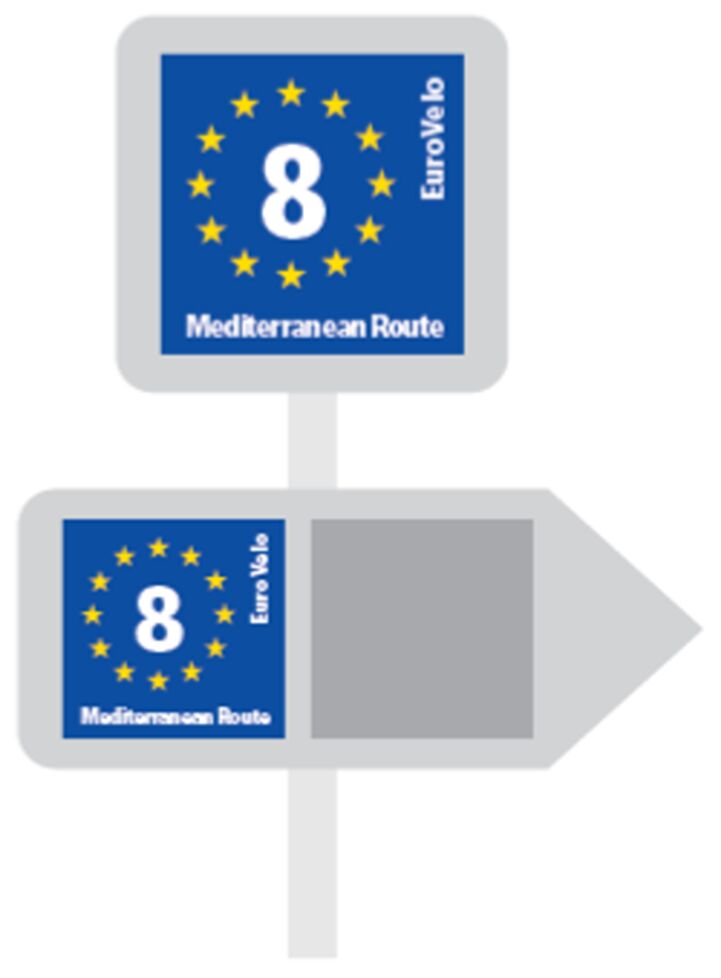EuroVelo signs: leading your (cycle) way across Europe
Did you know that you can find EuroVelo signs in 24 countries?
24 countries and 24 types of EuroVelo signs, spanning over 33,000 km of cycle routes. That’s 37% of the entire EuroVelo network. Wouldn’t it be a great challenge to make a pictures collection of signs from all countries? And who knows – if you start now, the 14 countries still missing EuroVelo signs might install them by the time you finish!
To help you get started, look at the map below which displays signed sections of the EuroVelo network. As you can see, some countries are more covered in yellow than others. That’s the case of France, the unchallenged winner when it comes to the number of EuroVelo signs in place: you can follow more than 8,000 km of cycle routes without looking at your map or screen for directions! The runner-ups are Ireland (almost 2,400 km of signed routes), Austria and Spain (around 2,100 km of signed routes for both).

But we don’t have the same winners if we look at percentages. Indeed, only two countries across the network have signed the entirety of their EuroVelo routes: Belgium and Estonia. France and Ireland are not far behind though, with over 90% of their respective EuroVelo routes already signposted. Isn’t this a good argument to put these countries on your bucket list for next year’s cycle holidays?

Now, if your dream is to cycle a whole EuroVelo route while letting go of all fears of getting lost, look at the 100% signed routes - EuroVelo 17 – Rhone Cycle Route and EuroVelo 19 – Meuse Cycle Route - and set off for over 1,000 km of cycling, nice and guided by EuroVelo signs!
Curious to know more? This year’s EuroVelo Route Development Status Report lists facts and figures about the status of the network in 2023, such as EuroVelo routes and countries with the highest percentages of developed sections, the progress made since 2022, and where improvements are most urgently needed to reach a fully developed network by 2030.
Everybody loves maps and not everyone loves stats, but what do these signs actually look like?
Looking around, we realised that the EuroVelo website is curiously void of pictures of EuroVelo signs. As a first step to remedy this issue, we decided to include some examples in this article. Look carefully at the image below: can you guess where each sign is coming from? You’ll find the answers at the bottom of this article!


As you can see from these pictures, EuroVelo signs don’t always look alike in different countries. They can be found as standalone signs with backgrounds of various colours, integrated on urban signposts, on wooden posts, on route information boards… What they have in common is the EuroVelo route information panel, displaying the unique number associated to each EuroVelo route and including the following elements:
- Council of Europe blue background colour
- EuroVelo route number in white
- Council of Europe yellow stars
- EuroVelo route name (optional, can be in the local language)
- EuroVelo network name (optional)
EuroVelo route information panels can be found in different versions as described in the EuroVelo Brand Guide: either the full version, with or without route and network names, or the frame version (as on picture 21), for combined usage with other route information panels.
And that’s all you need to know to never miss a EuroVelo sign in the wild!
For all the sign nerds out there: learn more in the EuroVelo Transnational Signing Manual!
The EuroVelo Transnational Signing Manual was written in the framework of the AtlanticOnBike project, focusing on EuroVelo 1 – Atlantic Coast Route, but it covers the whole EuroVelo network. This manual presents the most general principles for signing long-distance cycle routes, and the specific requirements for incorporating EuroVelo route information panels.
Without going into the details, we can already tell you that there are nine golden principles for signing long-distance cycle routes, which are valid anywhere across EuroVelo, and beyond:
- Signing should be in line with the relevant (trans)national standards and regulations;
- Long-distance cycle routes should be signed in both directions;
- Signing should be continuous and consistent throughout the itinerary;
- Signs should be easily legible by cyclists, located in the cyclists’ field of vision, have sufficient size and adequate contrast;
- Information on signs should be correct, sufficient and easy to understand;
- Adequate information should be provided at border crossing points and main junctions;
- Information should be provided in advance at complex junctions;
- Confirmation signs should be provided after junctions;
- Confirmation signs should be provided on long sections without junctions
The manual details these principles, including many examples and good practices. It also connects the signage requirements for EuroVelo routes with relevant criteria of the European Certification Standard methodology, providing concrete guidelines for high-quality cycle routes.
Let’s put the spotlight here on a good practice mentioned in the manual, which is very relevant for the transnational identity of EuroVelo. Did you know that when cycling on EuroVelo 12 – North Sea Cycle Route, you could easily miss the border between The Netherlands and Flanders? Scroll up and look again at the big image full of EuroVelo signs in the previous paragraph. You’ll see that the signs on images 12 and 17 look very similar – that’s because long-distance cycle routes signage has been harmonised across the border, ensuring a continuous cycling experience along the route! If only borders could always be as transparent as on EuroVelo routes…
Article by Florence Grégoire
And now, Results of the game: where do these EuroVelo signs come from?
- 1 - Gdansk, Poland
- 2- Finland
- 3 - Hessen, Germany
- 4 - It’s a trick! Maybe the only EuroVelo sign in Sweden…
- 5 - Portugal
- 6 - Near Zadar, Croatia
- 7 - Switzerland
- 8 - Ireland
- 9 - Near Belgrade, Serbia
- 10 - Hungary
- 11 - Denmark
- 12 - Flanders, Belgium
- 13 - Po Valley, Italy
- 14 - Austria
- 15 - Castilla y Léon, Spain
- 16 - Nordkapp, Norway – that’s the northernmost sign of EuroVelo 1 – Atlantic Coast Route!
- 17 - The Netherlands
- 18 - Brussels, Belgium
- 19 - Ephesus, Türkiye
- 20 - Slovenia
- 21 - France
- 22 - United Kingdom